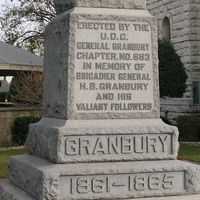|
| While
the descendents of the General spell the family name Granberry and
it appears as Granberry on his tombstone, the town and his statue
on the courthouse
lawn are spelled Granbury
as are most historical references to the man. |
 |
The
son of a Mississippi Baptist minister, Hiram moved near Waco
in the 1850s where he became a lawyer and served as chief justice
of McLennan County. During the Civil War Granberry recruited troops
to serve in the Waco Guards, a unit in General Gregg's brigade.
As a Major, Granberry was captured by Union troops in February of
1862. After an officers' exchange that same year, he was promoted
to Colonel upon his return to duty. Granberry saw action in Louisiana
and Mississippi was wounded at Chickamauga and saw further action
at Missionary Ridge. He eventually commanded his own brigade and became
Brigadier General in early 1864. He served in Cleburne's division
of Gen. Johnston's Army of Tennessee and led his troops in General
John B. Hood's invasion of Tennessee. It was at the battle of Franklin
in late1864 that Granberry was killed in action. First buried near
where he fell, his body was reinterred near Columbia, Tennessee and
in 1893, twenty-eight years after the end of the war, his remains
were brought to the Texas city named in his honor. |
Granbury
is the county seat of Hood County -named after Granberry's commanding
officer. Hood County sits in a cluster of Texas
counties named after Confederate generals Cleburne, Gregg, and
Johnson.
The statue on the courthouse
lawn was imported from Italy while the base was furnished by Waxahachie
monumentalist James Youngblood. It was erected in 1913.
Copyright © 2006 by Sam
Fenstermacher, All rights reserved |
|
|
